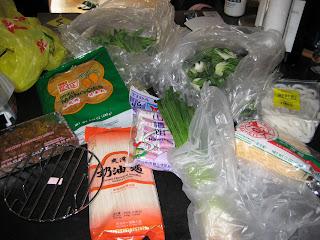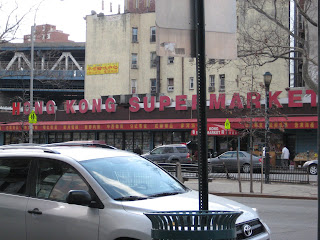

Along East Broadway in New York City's Chinatown, there are various stores and markets, selling everything from baked goods to fish balls. I stopped by two of them today to comparison shop.
New York Supermarket75 East Broadway
New York, NY 10002Located in a slightly hidden mini-mall directly under the Manhattan Bridge, you have to get past a corridor with small stores that smell of perm solutions (appetizing, no?) to get to the New York Supermarket. Don't worry - the market itself doesn't smell or seem to be contaminated. The fruit section of the market is in a covered, outdoor area, but the vegetables and other food are located inside the store. This supermarket has the usual Chinese fruits - Durian, Persimmons, Kumquats, etc. - and vegetables - bok choy, pea shoots, winter melon, etc. Everything looked pretty fresh. I found scallions at a great price (3 for $1.00)! The space itself is well-lit, but the aisles are a little tight.
Hong Kong Supermarket109 East Broadway
New York, NY 10002The Hong Kong Supermarket is the 800 lb. gorilla of Chinatown supermarkets. They have a huge space and a ton of selection. Reviews on the internet of this supermarket are unfairly harsh. People think that this is a dark and dirty spot. I'm not sure what standards they are applying because I find the Hong Kong Supermarket to be brighter and cleaner than most American supermarkets in the city.
ComparisonInterestingly enough, the fruit selection (located outside of the Hong Kong Supermarket) was much bigger and better than the New York Supermarket, but the vegetable section (again, located inside) was not very good. The aisles were bigger than the New York Supermarket, and just because the sheer size of the place, Hong Kong Supermarket has much more selection.
As for prices, I found that noodles (both fresh and dried) were slightly cheaper at New York Supermarket than at Hong Kong Supermarket. However, for other goods, Hong Kong Supermarket served a beat down to New York Supermarket by a wide margin. Here is a quick comparison:
Fresh Lo Mein Noodles ($1.39 at New York Supermarket, $1.49 at Hong Kong Supermarket)
Gold Key Dried Mangoes ($4.99 at New York Supermarket, $3.49 at Hong Kong Supermarket)
Kadoya Sesame Oil ($4.19 at New York Supermarket, $3.99 at Hong Kong Supermarket)
25lb. bag of Golden Crown Brand Jasmine Rice (N/a at New York Supermarket, $14.99 at Hong Kong Supermarket)
As a side note, do you know how difficult it is to carry a 25lb. bag of rice around NYC? It must be like carrying a small child around with you everywhere. Now, I understand the plight of young mothers with their small children on the subway! Except, I would imagine that young mothers can't (or shouldn't!) throw their small children on the ground like I did with my bag of rice.
Note: This blog is in no way affiliated with either of these businesses mentioned in this post. This is the sole opinion of Mystery Ter.











